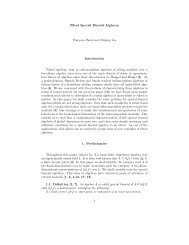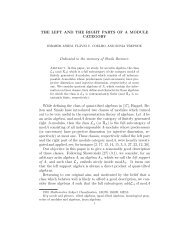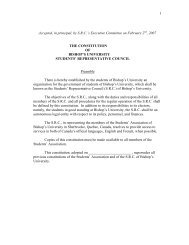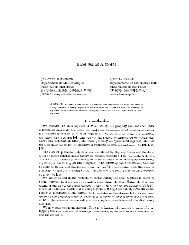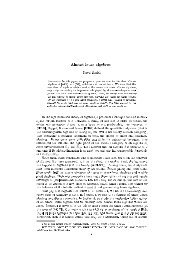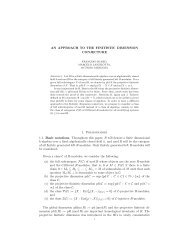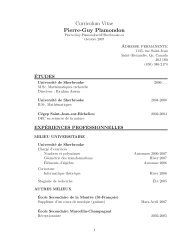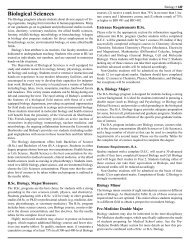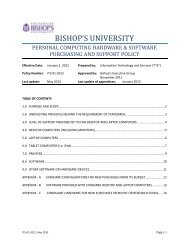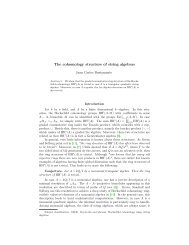Hochschild Cohomology and Representation-finite Algebras Ragnar ...
Hochschild Cohomology and Representation-finite Algebras Ragnar ...
Hochschild Cohomology and Representation-finite Algebras Ragnar ...
You also want an ePaper? Increase the reach of your titles
YUMPU automatically turns print PDFs into web optimized ePapers that Google loves.
22<br />
(1) If p isapathofQ A that does not lie completely in Q C but contains ρ as a<br />
subpath, then p ∈ I A .<br />
Next, write ¯x = x + I A ∈ A for x ∈ kQ A . For simplicity, we identify the vertex<br />
set of Q A with a complete set of orthogonal primitive idempotents of A. SinceA is<br />
<strong>finite</strong> dimensional, there exists an integer m ≥ 4 such that ¯ρ m =0<strong>and</strong> ¯ρ m−1 ≠0.<br />
Now<br />
ᾱ n ¯ρ 2 =ᾱ n ᾱ 1 ···ᾱ n =ᾱ n ¯ρᾱ 1 ···ᾱ n =ᾱ n ¯ρ¯ρ 2 =ᾱ n ¯ρ 3 = ···=ᾱ n ¯ρ m =0.<br />
Thus, α n ρ 2 ∈ I A <strong>and</strong> analogously ρ 2 α 1 ∈ I A . We now show the following:<br />
(2) If p is a non-trivial path of Q A different from ρ, thenρ m−2 p, pρ m−2 ∈ I A .<br />
As a consequence, ¯ρ m−1 lies in the socle of A.<br />
In fact, write p = p 1 β with β an arrow. If β ≠ ρ, using (1) together with<br />
α n ρ 2 ∈ I A <strong>and</strong> m ≥ 4, we infer that βρ m−2 ∈ I A . If β = ρ, thenp 1 is non-trivial<br />
<strong>and</strong> we can write p 1 = p 2 γ,withγ an arrow. Then γβρ m−2 = γρ m−1 ∈ I A ,<strong>and</strong><br />
therefore pρ m−2 ∈ I A . Similarly, ρ m−2 p ∈ I A , <strong>and</strong> we have established statement<br />
(2).<br />
Now let ∂ be the unique normalized derivation of kQ A with ∂(ρ) =ρ m−1 <strong>and</strong><br />
∂(α) = 0 for any arrow α ≠ ρ. Our next claim is:<br />
(3) If p isapathofQ A that is different from ρ, then∂(p) ∈ I A .<br />
This is trivially true if p is of length at most one. Assume thus that p is nontrivial<br />
<strong>and</strong> that (3) holds for paths shorter than p. If ρ does not appear in p,<br />
then ∂(p) =0. Otherwisep = uρv, whereu, v are paths shorter than p with u<br />
or v non-trivial. Now ∂(p) =∂(u)ρv + uρ m−1 v + uρ∂(v). It follows from (2) that<br />
uρ m−1 v ∈ I A . Moreover, if u ≠ ρ, then∂(u) ∈ I A by the inductive hypothesis.<br />
Otherwise ∂(u)ρv = ρ m v ∈ I A . Similarly, uρ∂(v) ∈ I A . Therefore, ∂(p) ∈ I A ,which<br />
proves statement (3).<br />
Since I A is generated by linear combinations of paths of length at least two,<br />
∂(I A ) ⊆ I A by (3). Hence ∂ induces a normalized derivation δ of A with δ(ȳ) =∂(y)<br />
for all y ∈ kQ A . We now wish to show that δ is an outer derivation of A. Assume<br />
on the contrary that δ = [x, −] forsomex ∈ A. Write x = x 1 + x 2 , where<br />
x 1 ∈ Aa + aA <strong>and</strong> x 2 ∈ a ′ Aa ′ ,wherea ′ =1− a. Thenδ(ρ) =[x 1 , ¯ρ] =¯ρ m−1 ≠0.<br />
Thus x 1 ∉ aAa since ¯ρ lies in the center of aAa. Therefore x 1 = z 1 + z 2 + z, where<br />
z 1 ∈ a ′ Aa, z 2 ∈ aAa ′ , z ∈ aAa <strong>and</strong> z 1 + z 2 ≠ 0. However, this would imply that<br />
δ(a) =z 1 − z 2 ≠ 0, contrary to δ being normalized. Hence [δ] is a non-zero element<br />
of HH 1 (A).<br />
Let M be a minimal representation generator of A such that Λ =End A (M). By<br />
Proposition 3.8, there exists an exact sequence<br />
0 → HH 1 (Λ) → HH 1 (A) −→ χM<br />
Ext 1 A(M,M) .<br />
ε<br />
We want to show that [δ] ∈ Ker(χ M ). Let P 1 −→ P 0 −→ M → 0 be a minimal<br />
projective presentation of M. Letb 1 ,...,b n <strong>and</strong> c 1 ,...,c m be vertices of Q A such<br />
that P 1 = ⊕ n j=1 b jA <strong>and</strong> P 0 = ⊕ m i=1 c iA. The matrix of φ is then (x ij ) m×n with<br />
x ij ∈ c i rad(A) b j . Since δ is normalized, δ(c i Ab j ) ⊆ c i Ab j . Hence the matrix of<br />
δ(φ) :P 1 → P 0 is (δ(x ij )) m×n . For each fixed 1 ≤ i ≤ m, we consider the i-th row<br />
(x i1 ,x i2 ,...,x in )ofthematrixofφ. Ifc i ≠ a, thenδ(x ij ) = 0 for all 1 ≤ j ≤ n by<br />
(3). Thus,<br />
(δ(x i1 ),δ(x i2 ),...,δ(x in )) = 0 · (x i1 ,x i2 ,...,x in ) .<br />
φ



